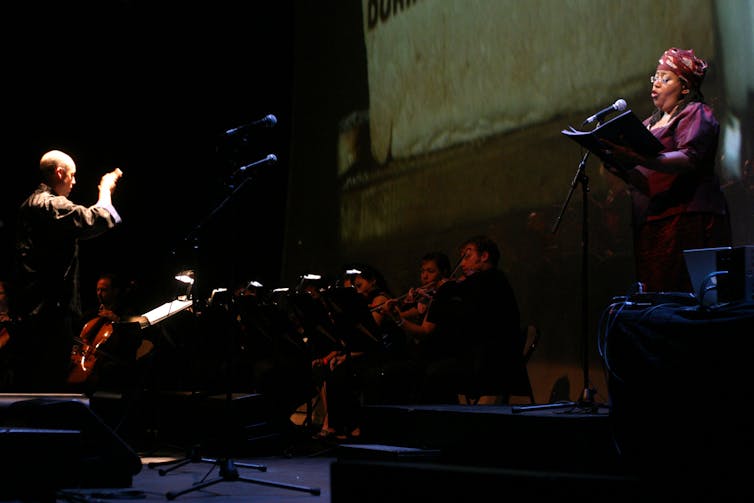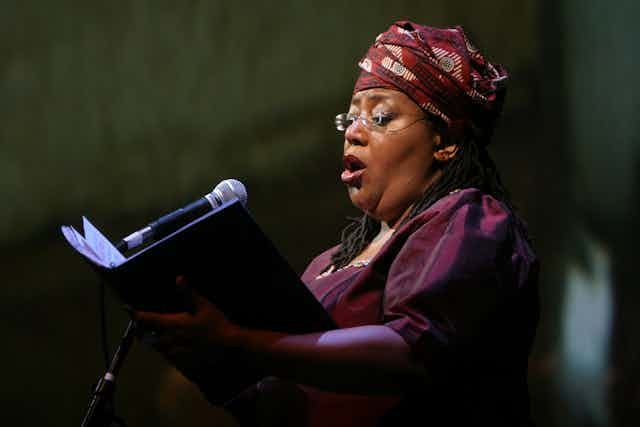South African singer Sibongile Khumalo (1957-2021) was born into a dynasty of musicians. Her grandfather was a maskandi artist. This is a popular form derived from indigenous Zulu music created by migrant labourers, mostly accompanied by an acoustic guitar. Her father, Khabi Mngoma, was a classical musician, a community builder in Soweto and, ultimately, a music professor at the University of Zululand.
Undoubtedly, it was her mother, Grace Mngoma, who bestowed her with her warm mezzo-soprano/alto voice. In numerous sources, including writer and activist Es’kia Mpahlele’s memoir Down Second Avenue, Grace is mentioned as an alto soloist in productions of Handel’s Messiah that her husband Khabi organised and hosted in Soweto and Johannesburg as far back as the late 1950s.
Sibongile’s brother Lindumuzi, part of the Ionian Male Choir, plays the cello; her niece Sibongile Mngoma is a versatile jazz and opera artist. Her son is a violinist, while her daughter sings. Outside the family circle, Sibongile’s earliest choral encounters were in Emily Motsieloa’s Tiny Tots children’s choir.
Notably, then, hers was a talent also nurtured by women musicians at a time when this was unthinkable in apartheid South Africa. I suggest that it is from this female-centred environment that Sibongile particularly looked out and was always encouraging to young female singers charting their way in the world of opera performance.
It is through her activities in choral music and opera that I particularly wish to celebrate her life and contribution.
Choral traditions
Her involvement in choral activities did not decline as an adult. The Ford Choirs competition (now the Old Mutual National Choir Festival) is one of the spaces Sibongile illustriously participated in. This is a competition for community choirs established in 1977 and given direction and shape by her father Khabi. Incidentally, her nephew, Bandile Mngoma, is in the marketing team of the competition through his work at Old Mutual. In the early 1980s she sang with the accomplished Soweto-based Imilonji ka Ntu choral society. Her memorable performances include a 1983 win as part of a double quartet/octet.
Through her involvement in community choirs one can surmise that Sibongile’s close familiarity with the broad range of the South African Black choral repertoire led to her inclusion of classics such as John Knox Bokwe’s Plea for Africa, Joshua Pulumo Mohapeloa’s U Ea Kae/Where are you going, Michael Moerane’s Della and B.P.J. Tyamzashe’s Isithandwa Sam/My Beloved to her discography. Even Professor Mzilikazi Khumalo’s first composition Ma Ngificwa Ukufa/On My Demise gets a brief appearance as part of a medley.
UShaka and Mzilikazi Khumalo
Though no relation, Sibongile’s collaboration with legendary South African composer and academic Mzilikazi Khumalo is worth dwelling on here. It was in his secular cantanta UShaka that her voice gave the nation and the world a glimpse of the possibilities for classical singing in local vernaculars.
This pioneering work premiered in 1996 with a live broadcast on South Africa’s public broadcaster, SABC TV, and was subsequently recorded in 1997. Community choirs provided the chorus, accompanied by the South African National Symphony Orchestra. Sibongile went on to perform in this work in Europe in 2004 and the USA in 2006.

The songs of Princess Magogo
Two related outcomes emerged from UShaka, I suggest. The first was the desire of Prof Khumalo, the composer, to have the songs of Princess Magogo KaDinizulu – Zulu princess, poet and composer – adapted for art singing and delivered by Sibongile. To this end, in 2000, he completed the song cycle Haya Mntwan’ Omkhulu/Sing Great Princess consisting of eight songs of Princess Magogo. The South African Music Rights Organisation appointed composer Peter Klatzow to set the music and provide orchestral accompaniment.
This work was particularly revolutionary and transformative. It overhauled the ways of approaching how vocal music was taught in South Africa’s academies over the years. Gradually, there emerged a body of art songs in local languages, telling local stories and revealing the sheer beauty of vernacular poetry. In 2002 Opera Africa commissioned Prof Khumalo to compose an opera on the story of Princess Magogo. Sibongile featured as the lead. Her performance drew critical acclaim locally and abroad.
Contemporary classics
While Sibongile performed numerous operatic roles with great flair, it is her pioneering work singing South African compositions that I particularly wish to highlight. Her appearance in composer Philip Miller’s 2007 work REwind: A Cantata for Voice, Tape & Testimony, the libretto of which is created from testimonies before South Africa’s Truth and Reconciliation Commission, was remarkably poignant and relevant.
Read more: Remembering Sibongile Khumalo, South Africa's divine diva
Composer and academic Bongani Ndodana-Breen’s 2013 Credo is crafted from the idealism of the Freedom Charter. This 1955 document contains the principles of freedom and equality that were a driving force in South Africa’s struggle for freedom, finally realised in 1994 with the advent of democracy. As can be expected, not only did Sibongile deliver with aplomb, she embodied these ideals with her mark of experience having lived through apartheid and championed freedom and democracy throughout her adult life through performance and education.
A prophetic aura
Thus, in a markedly feminist, decolonial and profoundly transformative way, Sibongile’s voice and persona hold significance in the history of choral and art music in South Africa, especially in the post-apartheid dispensation.
During the Caltex-Sowetan Nation Building massed choir festivals she was a torch bearer and significantly influenced a generation of young people, especially women, to take up opera and classical singing as a career. Young artists and students emulated her example and added into their repertoires some of the songs from Haya Mntwan’ Omkhulu and the arias from the opera Princess Magogo.
Her performances, her stature and of course her classical vocal training helped democratise South African opera, which had been largely far removed from the realities of Black South Africans.
Perhaps, akin to Princess Magogo, there was a strong sense of a prophetic aura in her work. It is hard to imagine her no longer living amongst us, but the “first lady of song” ran her race superbly. We should not mourn Sibongile Khumalo and pave her journey with tears. She gave all she was tasked to bequeath upon us, with joy, kindness, humour and generosity. Her time to join the ancestors had come. Hamba kahle Nomzwilili.

